0
Permanent Magnet Synchronous and Brushless DC Motor Drives
Contents
Preface
Acknowledgments
Author
List of Symbols
01
Part I: Introduction to Permanent Magnets and Machines and Converters and Control
1
Chapter 1: Permanent Magnets and Machines
1.1 PERMANENT MAGNETS
1.1.1 DEMAGNETIZATION CHARACTERISTICS
1.1.2 OPERATING POINT AND AIR GAP LINE
1.1.3 ENERGY DENSITY
1.1.4 ENERGY STORED IN THE MAGNET
1.1.5 MAGNET VOLUME
1.1.6 EFFECT OF EXTERNAL MAGNETIC FIELD INTENSITY
1.1.6.1 Analytical Approach
1.1.6.2 Graphical Approach
1.2 ARRANGEMENT OF PMs
1.3 MAGNETIZATION OF PMS
1.3.1 RADIAL AND PARALLEL MAGNETIZATIONS
1.3.2 HALBACH ARRAY
1.4 PM AC MACHINES
1.4.1 MACHINE CONFIGURATIONS
1.4.2 PM ROTOR TYPES
1.4.2.1 Surface-Mounted PMSM
1.4.2.2 Surface-Inset PMSM
1.4.2.3 Interior PMSM
1.4.2.4 Line-Start PMSM
1.4.3 HYBRID MACHINES
1.4.3.1 Flux Reversal PMSM
1.4.3.2 Flux Switching Machine
1.4.3.3 PM SRM or Doubly Salient PM Machine
1.4.4 CONCENTRATED COIL-WOUND PMSMS
1.4.5 TYPES OF PMSMS
1.5 FUNDAMENTALS OF SYNCHRONOUS MACHINES
1.5.1 PRINCIPLE OF OPERATION
1.5.2 MMF OF A COIL
1.5.3 SINUSOIDAL MMF DISTRIBUTION
1.5.3.1 Concentric Winding
1.5.3.2 Distributed Winding
1.5.4 INDUCED EMF
1.5.4.1 Winding Distribution Factor
1.5.4.2 Winding Pitch Factor
1.5.4.3 Skew Factor
1.5.4.4 Winding Factor
1.5.5 TYPES OF WINDINGS
1.5.5.1 Single-Layer Winding
1.5.5.2 Double-Layer Winding
1.5.6 ROTATING MAGNETIC FIELD
1.5.6.1 Sinusoidal MMF Distribution
1.5.6.2 Rectangular MMF Distribution
1.6 FUNDAMENTAL SYNCHRONOUS MACHINE RELATIONSHIPS
1.6.1 EFFECTIVE AIR GAP
1.6.2 EFFECT OF MAGNET ON INDUCED EMF
1.6.3 ELECTROMAGNETIC POWER AND TORQUE
1.6.4 FUNDAMENTAL REPRESENTATION OF ELECTROMAGNETIC TORQUE
1.6.5 MACHINE OUTPUT EQUATION
1.6.6 EQUIVALENT MAGNET CURRENT
1.6.7 SAFE PEAK STATOR CURRENT
1.6.8 INDUCTANCES
1.6.8.1 Self-Inductance per Phase
1.6.8.2 Magnetizing Inductance
1.6.8.3 Synchronous Inductance
1.6.8.4 d- and q-Axes Inductances
1.6.9 EFFECT OF STATOR EXCITATION ON AIR GAP FLUX DENSITY
1.7 CORE LOSSES
1.7.1 STATOR CORE LOSSES
1.7.2 EDDY CURRENT LOSSES
1.7.2.1 Eddy Current Loss in Tooth
1.7.2.2 Eddy Current Loss in Yoke
1.7.3 EVALUATION OF PEAK TOOTH AND YOKE FLUX DENSITIES
1.7.4 HYSTERESIS LOSSES
1.7.5 CORE LOSS MEASUREMENT IN THE MACHINE
1.8 RESISTIVE LOSSES
1.9 INITIAL MACHINE DESIGN
1.10 COGGING TORQUE
1.10.1 CAUSE AND MAGNITUDE
1.10.2 BASICS OF COGGING TORQUE
1.10.2.1 General Expression for Cogging Torque
1.10.3 ANALYSIS AND COMPUTATION
1.10.4 FACTORS AFFECTING COGGING TORQUE
1.10.5 MITIGATION METHODS
1.10.5.1 Skewing
1.10.5.2 Varying Magnet Width
1.10.5.3 Varying Slot Width
1.10.5.4 Shifting Alternate Pair of Poles
1.10.5.5 Notching of Teeth
1.11 BASIC TYPES OF PMSMS BASED ON FLUX PATHS
1.12 VIBRATION AND NOISE
REFERENCES
2
Chapter 2: Introduction to Inverters and Their Control
2.1 POWER DEVICE
2.1.1 POWER DEVICES AND SWITCHING
2.1.1.1 Power Diodes
2.1.1.2 MOSFET
2.1.1.3 Insulated Gate Bipolar Transistor
2.1.2 SWITCHING OF POWER DEVICES
2.1.3 DEVICE LOSSES
2.1.3.1 Conduction Loss
2.1.3.2 Switching Losses
2.2 DC INPUT SOURCE
2.2.1 DC INPUT SOURCE WITH DIODE BRIDGE RECTIFIER
2.3 DC TO AC POWER CONVERSION
2.3.1 SINGLE-PHASE HALF-WAVE INVERTER
2.3.2 SINGLE-PHASE FULL-WAVE INVERTER
2.3.3 THREE-PHASE INVERTER
2.4 REAL POWER
2.5 REACTIVE POWER
2.6 NEED FOR INVERTER CONTROL
2.7 PULSE WIDTH MODULATION
2.7.1 PWM IMPLEMENTATION
2.7.1.1 Reference Signal Generation
2.7.1.2 Sampling of Reference Signals
2.7.1.3 Transfer Characteristics of PWM-Controlled Inverters
2.7.1.4 Off-Line Optimized PWM
2.8 HYSTERESIS CURRENT CONTROL
2.9 SPACE VECTOR MODULATION
2.9.1 SWITCHING STATES OF THE INVERTER
2.9.2 PRINCIPLE OF SPACE VECTOR MODULATION
2.9.2.1 Transfer Characteristics of SVM-Controlled Inverters
2.9.3 SPACE VECTOR MODULATOR IMPLEMENTATION
2.9.4 SWITCHING RIPPLE IN SVM
2.9.4.1 Hybrid PWM Controller
2.10 INVERTER SWITCHING DELAY
2.10.1 CONTROL MODELING OF THE THREE-PHASE INVERTER
2.11 INPUT POWER FACTOR CORRECTION CIRCUIT
2.11.1 SINGLE-PHASE POWER FACTOR CORRECTION CIRCUIT
2.11.2 THREE-PHASE POWER FACTOR CORRECTION CIRCUIT
2.12 FOUR-QUADRANT OPERATION
2.13 CONVERTER REQUIREMENTS
REFERENCES
21
Part II: Permanent Magnet Synchronous Machines and Their Control
3
Chapter 3: Dynamic Modeling of Permanent Magnet Synchronous Machines
3.1 REAL-TIME MODEL OF A TWO-PHASE PMSM
3.2 TRANSFORMATION TO ROTOR REFERENCE FRAMES
3.3 THREE-PHASE TO TWO-PHASE TRANSFORMATION
3.3.1 UNBALANCED OPERATION
3.4 ZERO SEQUENCE INDUCTANCE DERIVATION
3.5 POWER EQUIVALENCE
3.6 ELECTROMAGNETIC TORQUE
3.7 STEADY-STATE TORQUE CHARACTERISTICS
3.8 MODELS IN FLUX LINKAGES
3.9 EQUIVALENT CIRCUITS
3.10 PER UNIT MODEL
3.11 DYNAMIC SIMULATION
3.12 SMALL-SIGNAL EQUATIONS OF THE PMSM
3.12.1 DERIVATION
3.13 EVALUATION OF CONTROL CHARACTERISTICS OF THE PMSM
3.13.1 TRANSFER FUNCTIONS AND FREQUENCY RESPONSES
3.14 COMPUTATION OF TIME RESPONSES
3.15 SPACE PHASOR MODEL
3.15.1 PRINCIPLE
3.15.2 MODEL DERIVATION
REFERENCES
4
Chapter 4: Control Strategies for a Permanent Magnet Synchronous Machine
4.1 VECTOR CONTROL
4.2 DERIVATION OF VECTOR CONTROL
4.2.1 ELECTROMAGNETIC TORQUE
4.2.2 STATOR D- AND Q-AXIS CURRENTS IN STATOR REFERENCE FRAMES
4.2.3 MUTUAL FLUX LINKAGES
4.2.4 ROLE OF A TORQUE ANGLE IN MACHINE OPERATIONS
4.2.5 KEY RESULTS
4.3 DRIVE SYSTEM SCHEMATIC
4.3.1 TORQUE-CONTROLLED DRIVE SYSTEM
4.3.1.1 Hysteresis Current Controller
4.3.2 SIMULATION AND RESULTS OF A TORQUE-CONTROLLED DRIVE SYSTEM
4.3.3 SPEED-CONTROLLED DRIVE SYSTEM
4.3.3.1 Mutual Flux Programming
4.3.3.2 Torque Programming in the Flux-Weakening Region
4.3.4 SIMULATION AND RESULTS OF A SPEED-CONTROLLED DRIVE SYSTEM
4.4 CONTROL STRATEGIES
4.4.1 CONSTANT (δ = 90°) TORQUE ANGLE CONTROL
4.4.2 UNITY POWER FACTOR CONTROL
4.4.3 CONSTANT MUTUAL FLUX LINKAGES CONTROL
4.4.4 ANGLE CONTROL OF AIR GAP AND FLUX CURRENT PHASORS
4.4.5 OPTIMUM TORQUE PER UNIT CURRENT CONTROL
4.4.6 CONSTANT POWER LOSS CONTROL
4.4.7 MAXIMUM EFFICIENCY CONTROL
REFERENCES
5
Chapter 5: Flux-Weakening Operation
5.1 MAXIMUM SPEED
5.2 FLUX-WEAKENING ALGORITHM
5.2.1 INDIRECT CONTROL SCHEME
5.2.2 CONSTANT TORQUE MODE CONTROLLER
5.2.3 FLUX-WEAKENING CONTROLLER
5.2.4 SYSTEM PERFORMANCE
5.3 DIRECT FLUX WEAKENING
5.3.1 MAXIMUM PERMISSIBLE TORQUE LIMIT
5.3.2 SPEED CONTROL SCHEME
5.3.3 IMPLEMENTATION STRATEGY
5.3.3.1 Lookup Tables Realization
5.3.4 SYSTEM PERFORMANCE
5.4 PARAMETER SENSITIVITY
5.4.1 STATOR RESISTANCE VARIATION
5.4.2 ROTOR FLUX LINKAGE VARIATION
5.4.3 Q-AXIS INDUCTANCE VARIATION
5.5 MODEL-FREE (PARAMETER-INSENSITIVE) FLUX-WEAKENING METHOD
5.6 SIX-STEP VOLTAGE AND CONSTANT BACK EMF CONTROL STRATEGIES FOR PMSM
5.6.1 CONSTANT BACK EMF CONTROL STRATEGY
5.6.1.1 The Basics
5.6.1.2 Maximum Current in the Flux-Weakening Region
5.6.1.3 Operational Boundary
5.6.1.4 Maximum Speed in the Flux-Weakening Region
5.6.2 SIX-STEP VOLTAGE CONTROL STRATEGY
5.6.2.1 Fundamental Analysis
5.6.2.2 Steady-State Current in SSV Mode
5.6.2.3 Operational Boundary for the SSV Control Strategy
5.6.2.4 Comparison
5.7 DIRECT STEADY-STATE EVALUATION
5.7.1 INPUT VOLTAGES
5.7.2 MACHINE EQUATIONS IN STATE SPACE FORM
5.7.3 BOUNDARY MATCHING CONDITION AND SOLUTION
5.7.4 MATLAB® PROGRAM
5.8 FLUX WEAKENING IN SMPM AND IPM SYNCHRONOUS MACHINES
5.8.1 FLUX-WEAKENING EQUATIONS IN NEW BASE
REFERENCES
6
Chapter 6: Design of Current and Speed Controllers
6.1 CURRENT CONTROLLER
6.1.1 ROTOR REFERENCE FRAME CURRENT CONTROLLERS
6.1.2 STATOR REFERENCE FRAMES CURRENT CONTROLLER
6.1.3 DEADBEAT CURRENT CONTROLLERS
6.1.3.1 Deadbeat Controller
6.1.3.2 Predictive Deadbeat Controller
6.1.3.3 Improved Predictive Deadbeat Controller
6.2 SPEED CONTROLLER
6.2.1 DERIVATION OF BLOCK DIAGRAM
6.2.2 SIMPLIFIED CURRENT LOOP TRANSFER FUNCTION
6.2.3 SPEED CONTROLLER
6.2.3.1 Smoothing
REFERENCES
7
Chapter 7: Parameter Sensitivity and Compensation
7.1 INTRODUCTION
7.1.1 RATIO OF TORQUE TO ITS REFERENCE
7.1.2 RATIO OF MUTUAL FLUX LINKAGES TO ITS REFERENCE
7.2 PARAMETER COMPENSATION THROUGH AIR GAP POWER FEEDBACK CONTROL
7.2.1 ALGORITHM
7.2.2 PERFORMANCE
7.3 PARAMETER COMPENSATION BY REACTIVE POWER FEEDBACK CONTROL
7.3.1 PRINCIPLE OF THE REACTIVE POWER FEEDBACK COMPENSATION SCHEME
7.3.2 DRIVE SCHEMATIC
7.3.3 SIMULATION RESULTS
7.3.4 COMPARISON WITH AIR GAP POWER FEEDBACK SCHEME
REFERENCES
8
Chapter 8: Rotor Position Estimation and Position Sensorless Control
8.1 CURRENT MODEL ADAPTIVE SCHEME
8.2 SENSING BY EXTERNAL SIGNAL INJECTION
8.2.1 REVOLVING VOLTAGE PHASOR INJECTION SCHEME
8.2.2 FLUX LINKAGE INJECTION IN ROTATING Q-AXIS
8.2.2.1 Algorithm
8.2.2.2 Demodulation
8.2.2.3 Observer
8.2.2.4 Implementation
8.2.2.5 Merits and Demerits of the Scheme
8.2.3 ALTERNATING VOLTAGE PHASOR INJECTION
8.2.3.1 Sensorless Algorithm
8.2.3.2 Implementation
8.3 CURRENT MODEL-BASED INJECTION SCHEME
8.4 POSITION ESTIMATION USING PWM CARRIER COMPONENTS
8.4.1 HARMONIC VOLTAGE AND CURRENT VECTORS
8.4.2 ROTOR POSITION ESTIMATION
8.4.3 PERFORMANCE
REFERENCES
81
Part III: Permanent Magnet Brushless DC Machines and Their Control
9
Chapter 9: PM Brushless DC Machine
9.1 MODELING OF PM BRUSHLESS MOTOR
9.2 NORMALIZED SYSTEM EQUATIONS
9.3 THE PMBDCM DRIVE SCHEME
9.4 DYNAMIC SIMULATION
REFERENCES
10
Chapter 10: Commutation Torque Ripple and Phase Advancing
10.1 COMMUTATION TORQUE RIPPLE
10.2 PHASE ADVANCING
10.3 DYNAMIC MODELING
10.3.1 MACHINE EQUATIONS
REFERENCES
11
Chapter 11: Half-Wave PMBDCM Drives
11.1 SPLIT SUPPLY CONVERTER TOPOLOGY
11.1.1 OPERATION OF THE PMBDC MOTOR WITH THE SPLIT SUPPLY CONVERTER
11.1.2 OPERATIONAL MODES OF THE CONVERTER
11.1.3 MERITS AND DEMERITS OF THE PMBDC DRIVE WITH THE SPLIT SUPPLY CONVERTER
11.1.4 DESIGN CONSIDERATIONS FOR THE PMBDC MOTOR
11.1.5 IMPACT OF THE MOTOR INDUCTANCE ON THE DYNAMIC PERFORMANCE
11.1.6 WINDING CONNECTIONS
11.1.7 DRIVE SYSTEM DESCRIPTION
11.1.8 MODELING, SIMULATION, AND ANALYSIS OF THE PMBDC DRIVE SYSTEM
11.1.8.1 Modeling of the PMBDCM with Converter Modes
11.1.8.2 Modeling of the Speed Controller
11.1.8.3 Steering Circuit
11.1.8.4 Current Loop Modeling
11.1.8.5 Simulation and Analysis
11.1.8.6 Current Commutation Angle
11.1.8.7 Comparison of the Half-Wave and Full-Wave Inverter-Based PMBDC Drives
11.2 C-DUMP TOPOLOGY
11.2.1 PRINCIPLE OF OPERATION OF THE C-DUMP PMBDC DRIVE SYSTEM
11.2.1.1 Motoring Operation
11.2.1.2 Regenerative Operation
11.2.2 ANALYSIS OF THE C-DUMP PMBDCM DRIVE
11.2.2.1 Maximum Speed
11.2.2.2 Peak Recovery Current
11.2.2.3 Energy Recovery Capacitor
11.2.2.4 Energy Recovery Chopper
11.2.3 COMPARISON WITH FULL-WAVE INVERTER-CONTROLLED PMBDCM DRIVE
11.2.4 MODELING, SIMULATION, AND DYNAMIC PERFORMANCE
11.2.4.1 Modeling
11.2.4.2 System Performance
11.3 VARIABLE DC LINK CONVERTER TOPOLOGY
11.3.1 PRINCIPLE OF OPERATION
11.3.2 MOTORING
11.3.2.1 Regenerative Operation
11.3.3 SYSTEM PERFORMANCE
11.3.3.1 Torque Drive Performance
11.3.3.2 Speed-Controlled Drive Performance
11.3.4 MERITS AND DEMERITS
11.4 VARIABLE VOLTAGE CONVERTER TOPOLOGY WITH BUCK-BOOST FRONT-END
11.4.1 CONVERTER CIRCUIT
11.4.2 OPERATIONAL MODES AND MODELING OF THE PMBDC MOTOR DRIVE SYSTEM
11.4.3 MERITS AND DEMERITS
11.4.4 COMPARISON WITH FULL-WAVE INVERTER DRIVE
11.4.5 DESIGN OF THE INDUCTOR AND OUTPUT CAPACITOR IN THE BUCK-BOOST FRONT-END
11.4.6 CONTROL STRATEGIES AND PERFORMANCE
11.4.6.1 Strategy I—Open Loop Voltage Control
11.4.6.2 Strategy II—Closed Loop Voltage Control
11.4.6.3 Strategy III—Direct Phase Current Control
REFERENCES
12
Chapter 12: Design of Current and Speed Controllers
12.1 TRANSFER FUNCTION OF MACHINE AND LOAD
12.2 INVERTER TRANSFER FUNCTION
12.3 TRANSFER FUNCTIONS OF CURRENT AND SPEED CONTROLLERS
12.4 CURRENT FEEDBACK
12.5 SPEED FEEDBACK
12.6 DESIGN OF CONTROLLERS
12.6.1 CURRENT CONTROLLER
12.6.2 FIRST-ORDER APPROXIMATION OF INNER CURRENT LOOP
12.6.3 SPEED CONTROLLER
REFERENCES
13
Chapter 13: Sensorless Control of PMBDCM Drive
13.1 CURRENT SENSING
13.2 POSITION ESTIMATION
REFERENCES
14
Chapter 14: Special Issues
14.1 TORQUE SMOOTHING
14.2 PARAMETER SENSITIVITY OF THE PMBDCM DRIVE
14.3 FAULTS AND THEIR DIAGNOSIS
14.4 VIBRATION AND NOISE
REFERENCES
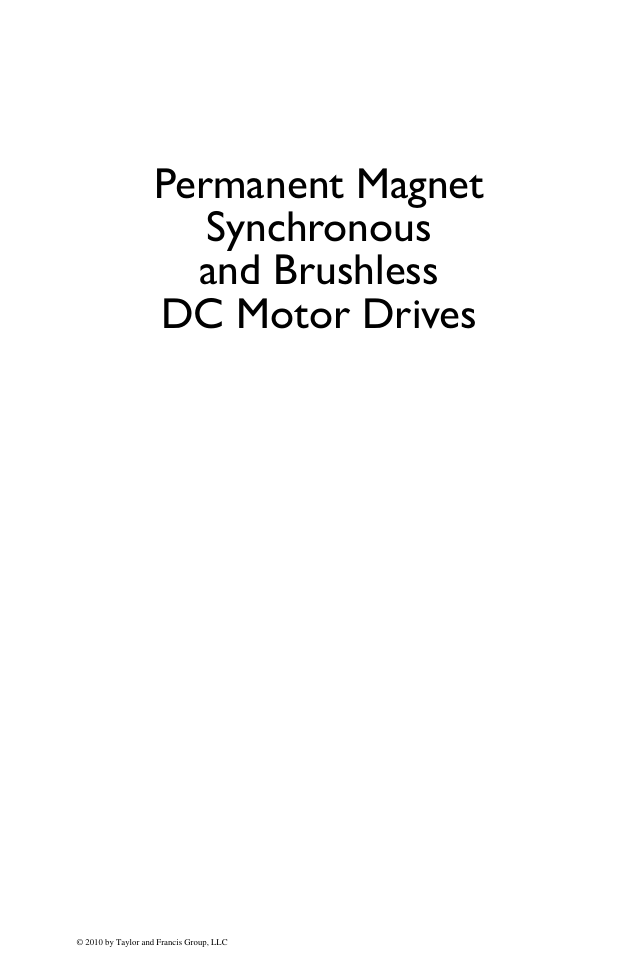

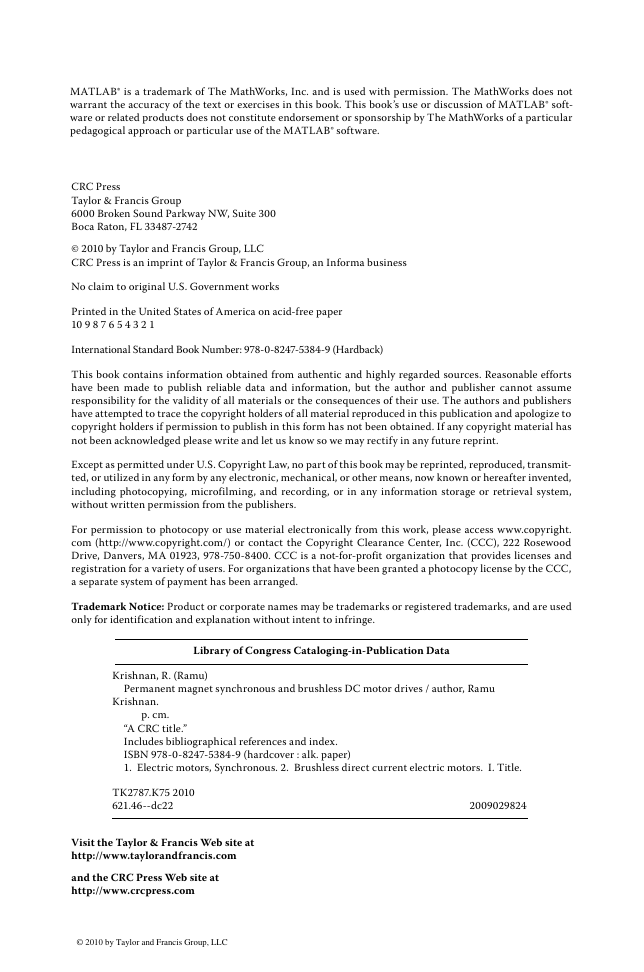
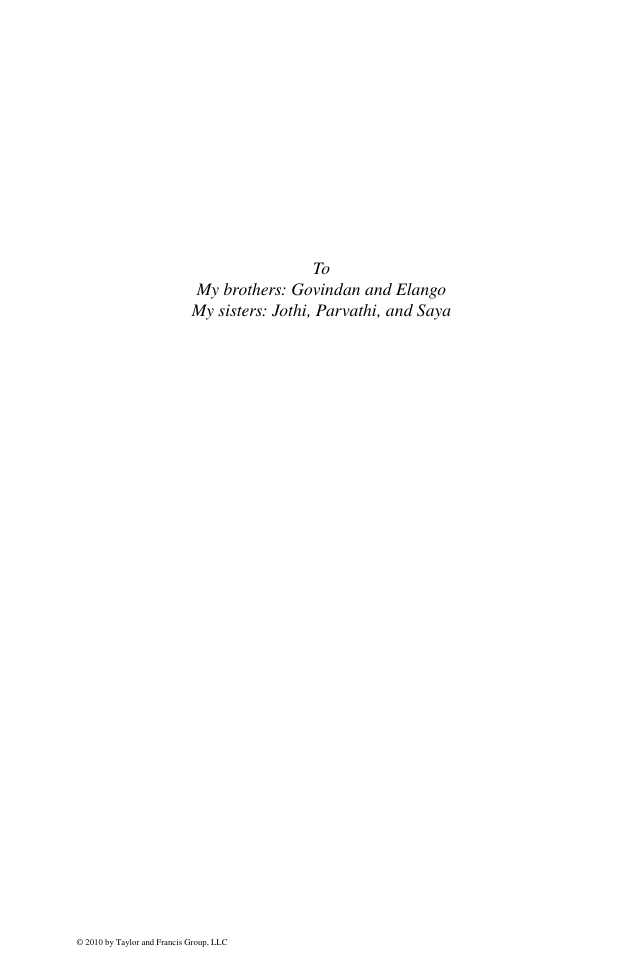
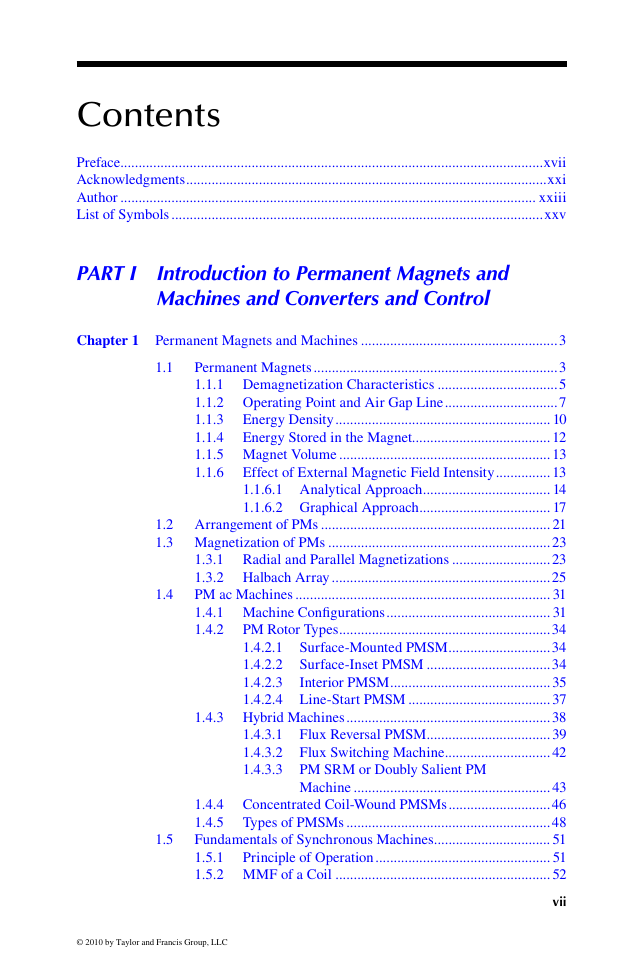

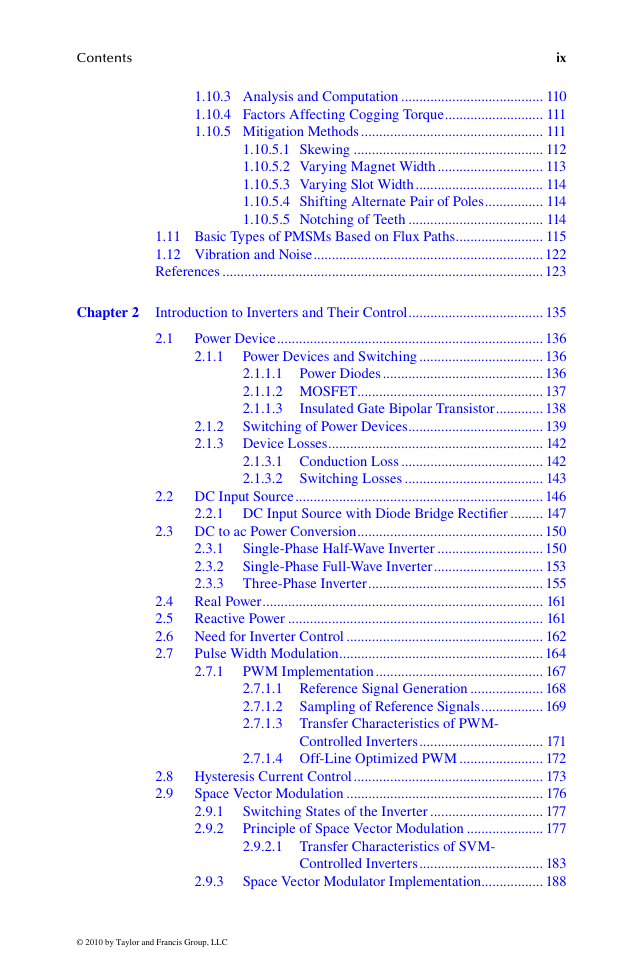
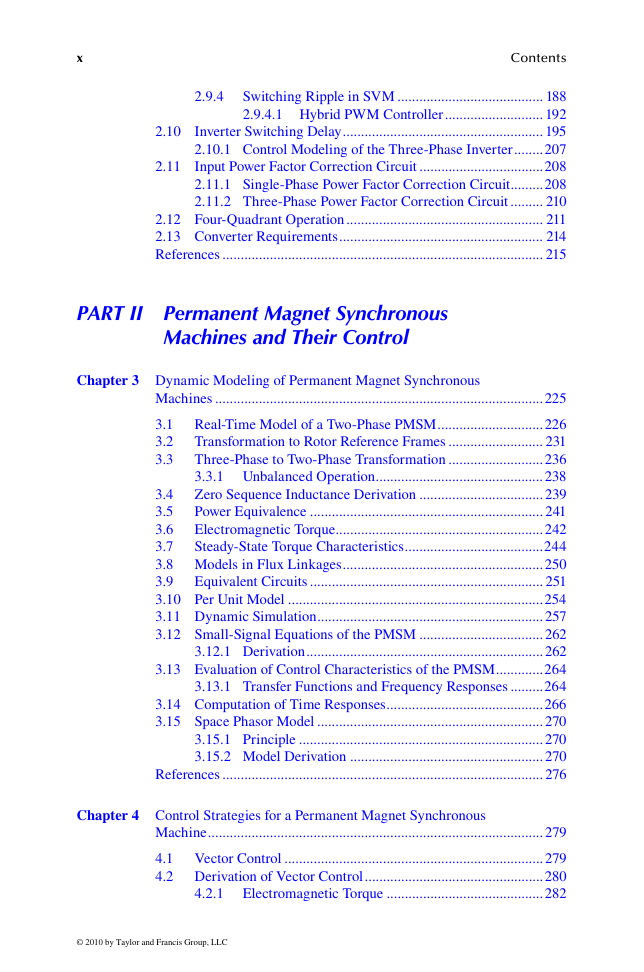








 2023年江西萍乡中考道德与法治真题及答案.doc
2023年江西萍乡中考道德与法治真题及答案.doc 2012年重庆南川中考生物真题及答案.doc
2012年重庆南川中考生物真题及答案.doc 2013年江西师范大学地理学综合及文艺理论基础考研真题.doc
2013年江西师范大学地理学综合及文艺理论基础考研真题.doc 2020年四川甘孜小升初语文真题及答案I卷.doc
2020年四川甘孜小升初语文真题及答案I卷.doc 2020年注册岩土工程师专业基础考试真题及答案.doc
2020年注册岩土工程师专业基础考试真题及答案.doc 2023-2024学年福建省厦门市九年级上学期数学月考试题及答案.doc
2023-2024学年福建省厦门市九年级上学期数学月考试题及答案.doc 2021-2022学年辽宁省沈阳市大东区九年级上学期语文期末试题及答案.doc
2021-2022学年辽宁省沈阳市大东区九年级上学期语文期末试题及答案.doc 2022-2023学年北京东城区初三第一学期物理期末试卷及答案.doc
2022-2023学年北京东城区初三第一学期物理期末试卷及答案.doc 2018上半年江西教师资格初中地理学科知识与教学能力真题及答案.doc
2018上半年江西教师资格初中地理学科知识与教学能力真题及答案.doc 2012年河北国家公务员申论考试真题及答案-省级.doc
2012年河北国家公务员申论考试真题及答案-省级.doc 2020-2021学年江苏省扬州市江都区邵樊片九年级上学期数学第一次质量检测试题及答案.doc
2020-2021学年江苏省扬州市江都区邵樊片九年级上学期数学第一次质量检测试题及答案.doc 2022下半年黑龙江教师资格证中学综合素质真题及答案.doc
2022下半年黑龙江教师资格证中学综合素质真题及答案.doc